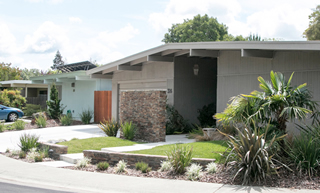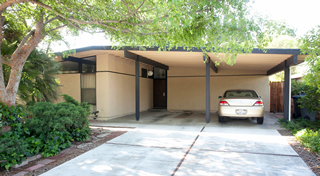Paths to Pleasure - Page 4
 |
 |
|
|
 |
|
|
"So many acres go for greenbelt. That reduces the amount of lots you get paid for," he says, "and in addition to setting aside acreage for greenbelts, it costs money to make it green, and then it costs money to keep it green."
Shortly after the greenbelts were installed, the land was turned over to the city as a park. The city maintains the greenbelts, which are pristine. "There's very little trash. People really police it," says Brian Millar, James' father.
In fact, the greenbelt did not attract buyers to the neighborhood when it was new because, although the greenbelts could be seen on paper, they did not exist. Nothing existed.
"There was nothing," Vickie Moering remembers, when she and her husband Paul arrived in the new neighborhood in 1978. "We could see clear to Sacramento. You could see all the way to the Sierras."
Part of the site had been tomato fields and part, says Carl Klein, an original owner a few streets down, were "the alkali flats."
"The clay was so hard," Bill Streng recalls, "we had to have one bulldozer pushing another bulldozer" to grade it.
But the grass grew quickly, Bill recalls, and soon Paul and Vickie's daughter was selling lemonade from a stand along the greenbelt and there were Easter Egg hunts. Jackie Kinney, a 14-year resident, has particularly enjoyed ‘Halloween on Hermosa' parties on the meadow.
Today, the greenbelt defines the neighborhood visually—and in more forceful ways. The first-time visitor to the neighborhood invariably gets lost—if he is in a car. That's because most streets are cul-de-sacs that stop a few tantalizing feet from one of the neighborhood's few through streets.
But you can't get to the through street by car—only by a pedestrian path, "so driving can be rather convoluted," Susan Handy says. "But it's easy enough to walk."
Throughout the neighborhood, she notes, "It's a shorter distance to walk or bike than it is to drive."
The trails may not have been a selling point when the neighborhood was new, but they are today.
"Quite frankly, I don't know if we would have been here if it weren't for the trail," says Brian Millar, who moved to the neighborhood with wife Angie in 2003.
"That's the reason we bought the house. We just fell in love with the greenbelt," says George Flamik, who moved in three years ago with wife Dina and two young daughters. They're refugees from San Francisco, where George still works, commuting by train.
They were attracted to the area by fine schools and by the modern architecture, as well as by the greenbelt. "I did not want to have the stereotypical suburban house that looks like everybody else's house," says Dina, who grew up in Estonia.
But it's the paths that make the neighborhood most appealing, they say. Their home borders one of the many short connectors that connect streets to the paths.
Dina, who pilots a tandem bike that can handle both Anastasia, 4, and Tatiana, 2-1/2, often heads for the greenbelt's playgrounds.




